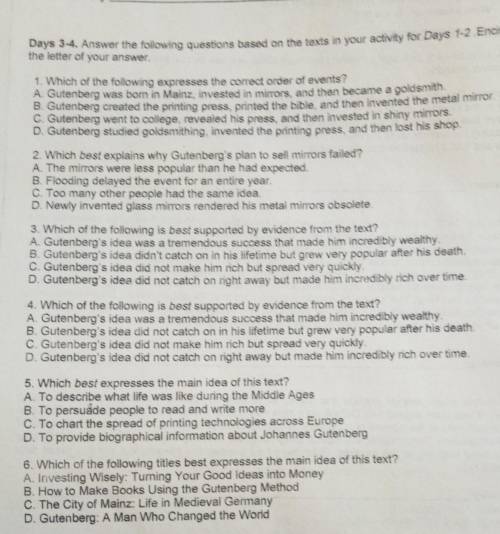
English, 11.02.2021 06:20, taliyahfelin
Days 3-4. Answer the following questions based on the texts in your activity for Days 1-2 . Encircle
the letter of your answer.
1. Which of the following expresses the correct order of events?
A Gutenberg was born in Mainz, invested in mirrors, and then became a goldsmith.
8. Gutenberg created the printing press printed the bible, and then invented the metal mirror
C. Gutenberg went to college, revealed his press, and then invested in shiny mirrors.
D. Gutenberg studied goldsmithing, invented the printing press, and then lost his shop.
2. Which best explains why Gutenberg's plan to sell mirrors failed?
A. The mirrors were less popular than he had expected.
B. Flooding delayed the event for an entire year.
C. Too many other people had the same idea.
D. Newly invented glass mirrors rendered his metal mirrors obsolete.
3. Which of the following is best supported by evidence from the text?
A. Gutenberg's idea was a tremendous success that made him incredibly wealthy.
B. Gutenberg's idea didn't catch on in his lifetime but grew very popular after his death.
C. Gutenberg's idea did not make him rich but spread very quickly.
D. Gutenberg's idea did not catch on right away but made him incredibly rich over time.
4. Which of the following is best supported by evidence from the text?
A. Gutenberg's idea was a tremendous success that made him incredibly wealthy.
B. Gutenberg's idea did not catch on in his lifetime but grew very popular after his death.
C. Gutenberg's idea did not make him rich but spread very quickly.
D. Gutenberg's idea did not catch on right away but made him incredibly rich over time.
5. Which best expresses the main idea of this text?
A. To describe what life was like during the Middle Ages
B. To persuade people to read and write more
C. To chart the spread of printing technologies across Europe
D. To provide biographical information about Johannes Gutenberg
6. Which of the following titles best expresses the main idea of this text?
A. Investing Wisely: Turning Your Good Ideas into Money
B. How to Make Books Using the Gutenberg Method
C. The City of Mainz: Life in Medieval Germany
D. Gutenberg: A Man Who Changed the World


Answers: 2
Other questions on the subject: English

English, 21.06.2019 20:20, Suphat
Read the following excerpt from life on the mississippi by mark twain. no girl could withstand his charms. he "cut out" every boy in the village. when his boat blew up at last, it diffused a tranquil contentment among us such as we had not known for months. but when he came home the next week, alive, renowned, and appeared in church all battered up and bandaged, a shining hero, stared at and wondered over by everybody, it seemed to us that the partiality of providence for an undeserving reptile had reached a point where it was open to criticism. how does twain's use of understatement serve his purpose? be sure to use specific details from the text to support your answer.
Answers: 3


English, 22.06.2019 09:00, ueuwuwj
Part 2: thoreau’s ideas had a profound effect on a man named gandhi. gandhi, was a leader in india who worked to end british rule. he led india to independence and inspired many to non-violent forms of protest and resistance. he fought to end poverty, worked to expand women's right to vote, and built bridges between ethnic and religious groups. like thoreau, he lived simply, owned very little, and ate a vegetarian diet. in india, gandhi's form of protest was called the "non-cooperation movement." he urged indians to boycott british education systems and leave government jobs. the movement was very popular, and in part to stop its spread, the british controlled government arrested him. after a few years, he was released and became active in politics again. he inspired many to follow him on marches to protest various taxes. on one such march, thousands followed him 240 miles over 24 days to the sea to protest a salt tax. this march set the example of non-violent resistance to the government that others in the country followed. eventually india won independence from britain, in large part because of gandhi work. gandhi's model of resistance and reform was creative, appealing, and successful. as a result, dr. martin luther king looked to gandhi when the time came to find a way to resist segregation in the south. the lunch counter protests, famous for the passive response to anger, and even violence, aimed to end the separation enforced by laws in some regions of the south. king also organized walks, marches, and bus rides that were meant to bring attention to the issues facing african americans. these forms of protest were directly modeled on gandhi's, but king took them straight to the source of oppression. where gandhi's protests created awareness and built momentum, king's protests were in the face of great hatred and fear. the passive, non-violent protests were ultimately effective, mainly because the passive response to violence cast the opposition as brutes. however, change came slowly and at the cost of many lives. king remained committed to peaceful protest, however, until his death. king learned from gandhi, expanding on what worked, applying old techniques to a new problem. gandhi owed his philosophy, in part, to a new england poet who loved the woods. read this sentence from part 2: like thoreau, he lived simply, owned very little, and ate a vegetarian diet. what is the point of this sentence? gandhi and thoreau had similar childhoods. gandhi had many admirable qualities. thoreau and gandhi were very similar. thoreau had a simple life compared to others.
Answers: 2
Do you know the correct answer?
Days 3-4. Answer the following questions based on the texts in your activity for Days 1-2 . Encircle...
Questions in other subjects:

Health, 28.09.2019 03:40

Mathematics, 28.09.2019 03:40

Mathematics, 28.09.2019 03:40







Biology, 28.09.2019 03:40






